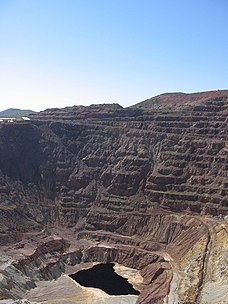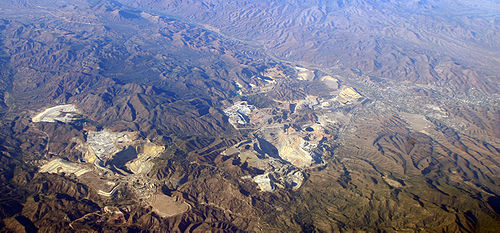| Copper mining in Arizona | |
|---|---|
 Position of Arizona Position of Arizona | |
| Location | |
| State | Arizona |
| Country | United States |
| Regulatory authority | |
| Authority | Arizona Department of Mines and Mineral Resources |
| Website | www |
| Production | |
| Commodity | Copper |
| Production | |
| Value | |
| Employees | |
| Year | 2007 |
In Arizona, copper mining has been a major industry since the 19th century. In 2007, Arizona was the leading copper-producing state in the country, producing 750 thousand metric tons of copper, valued at $5.54 billion. Arizona's copper production was 60% of the total for the United States. Copper mining also produces gold and silver as byproducts. Byproduct molybdenum from copper mining makes Arizona the nation's second-largest producer of that metal. Although copper mineralization was found by the earliest Spanish explorers of Arizona, the territory was remote, and copper could seldom be profitably mined and shipped. Early Spanish, Mexican, and American prospectors searched for gold and silver (see Silver mining in Arizona), and ignored copper. It was not until the completion of the Southern Pacific Railroad in 1876 that copper became broadly economic to mine and ship to market.
All copper mining was done by underground methods until the early 20th century. After the Bingham Canyon mine in Utah successfully mined a large low-grade copper deposit from a large open pit, the same technique was applied to Arizona's porphyry copper deposits. Arizona's first open pit copper mine opened at Ajo in 1917.

Copper mining districts

Jerome
Native Americans used copper minerals of the Verde district at modern-day Jerome as pigment to decorate skin and textiles. The first European to visit the area is thought to be Spanish explorer Antonio de Espejo, who found silver at a location in central Arizona in 1583. No mining resulted, and Juan de Oñate led another expedition searching for Espejo's silver location in 1598; many claims were staked, but the expeditioners returned to Santa Fe without mining any silver, and the deposits remained unexploited.
The United Verde mine exhausted the rich oxidized ores in 1884, and the mine closed. William A. Clark of Montana visited the district in 1888, bought it, and reopened the mine. The smelter at Clarkdale was built in 1915.
Ajo

Spaniards mined on a small scale at Ajo as early as 1750. After the Gadsden Purchase brought the southern Arizona into the United States in 1853, the mine was reopened in 1855, and shipped high-grade ore to Swansea in Wales. However, the remote desert location made mining generally uneconomic without onsite treatment. The area was mostly idle until the New Cornelia mine opened in 1917 as the first large open-pit mine in Arizona. Mining continued in the district until 1983. The district produced 6.304 billion pounds of copper.
Clifton-Morenci district
Prospectors from Silver City, New Mexico discovered copper mineralization at Morenci, also known as the Greenlee district in 1872. Mining began the following year, and miners extracted and smelted high-grade copper ore until a railroad reached the district in 1884 and a concentrator made mining and processing of low-grade ore economical.
The Morenci mine, owned jointly by Freeport-McMoran and Sumitomo, is the largest copper producer in the state, and regularly contributes about half of Arizona's copper production.
Bisbee (Warren district)
Main article: Bisbee, Arizona
An army scout noted copper mineralization in the Warren district at present-day Bisbee in 1877. Production began in 1880 after a rich discovery of copper oxide on the Copper Queen claim. The success of the Copper Queen mine convinced Phelps Dodge to buy the adjacent Atlantic claim in 1881. Phelps Dodge later bought control of the Copper Queen and adjacent claims.
Although Phelps Dodge was the largest mining company in Bisbee, it was not the only one. The Calumet and Arizona Mining Company organized in March, 1901 and operated several large and profitable mines adjacent to the Copper Queen. By 1907, the C&A was the fourth-most productive copper mine in Arizona, and ran its own smelter in Douglas, Arizona.
Phelps Dodge started mining the Lavender open pit in the early 1950s. The Lavender pit closed in 1974.
The Copper Queen mine, Bisbee's first working mine, was also its last. Mining stopped in 1975, although the Copper Queen still offers tours.
The Warren district is credited with having produced 7.92 billion pounds (3.59 million mt) of copper. In addition, the district recovered 324 million pounds (147,000 t) of lead, 355 million pounds (161,000 t) of zinc, 28 million pounds (13,000 t) of manganese, 2.79 million ounces (86.8 t) of gold and 102 million ounces (3177 t) of silver.
Globe-Miami district

Silver mining started at Globe in 1874. The silver mines shut down in 1877, but the following year copper mining took over.
White Mesa district
The White Mesa copper-mining district is in the western part of the Navajo reservation, 112 miles (180 km) northeast of Flagstaff, in Coconino County. The copper deposits consist of malachite and chrysocolla as grain coatings in the Jurassic Navajo Sandstone. They were first mined on a small scale by Mormon settlers in the 19th century, then briefly in 1917, and again 1939–1941. The district produced about 550,000 pounds of copper and a small amount of silver.
Copper mining today
| This section needs to be updated. Please help update this article to reflect recent events or newly available information. (November 2016) |
Significant active Arizona copper mines in 2012, by order of output:
| Rank | Mine | County | Operator | Source of copper | 2012 Cu Production (million lbs) | Reference |
|---|---|---|---|---|---|---|
| 1 | Morenci | Greenlee | Freeport-McMoRan | Copper-molybdenum ore, concentrated and leached | 632 | |
| 2 | Ray | Pinal | ASARCO | Copper ore, concentrated and leached | 213 | |
| 3 | Bagdad | Yavapai | Freeport-McMoRan | Copper-molybdenum ore, concentrated and leached | 197 | |
| 4 | Safford | Graham | Freeport-McMoRan | Copper ore, leached | 175 | |
| 5 | Sierrita | Pima | Freeport-McMoRan | Copper-molybdenum ore, concentrated and leached | 157 | |
| 6 | Mission Complex | Pima | ASARCO | Copper-molybdenum ore, concentrated | 134 | |
| 7 | Miami | Gila | Freeport-McMoRan | Copper ore, leached | 66 | |
| 8 | Silver Bell | Pima | ASARCO | Copper ore, leached | 45.9 | |
| 9 | Mineral Park | Mohave | Mercator Minerals | Copper-molybdenum ore, concentrated | 40.9 | |
| 10 | Carlota Mine | Gila | KGHM | Copper ore, leached | 23.3 |
Leading copper-producing mines in 2015
Leading copper-producing mines in the Arizona in 2015, in order of output:
| Rank | Mine | County | Operator | Source of copper | Capacity (thousands of metric tons) |
|---|---|---|---|---|---|
| 1 | Morenci | Greenlee | Freeport-McMoRan | Copper-molybdenum ore, concentrated and leached | 480 |
| 2 | Ray | Pinal | ASARCO | Copper ore, concentrated and leached | 150 |
| 3 | Mission Complex | Pima | ASARCO | Copper-molybdenum ore, concentrated | 150 |
| 4 | Safford | Graham | Freeport-McMoRan | Copper ore, leached | 110 |
| 5 | Bagdad | Yavapai | Freeport-McMoRan | Copper-molybdenum ore, concentrated and leached | 100 |
| 6 | Miami | Gila | Freeport-McMoRan | Copper ore, leached | 90 |
| 7 | Sierrita | Pima | Freeport-McMoRan | Copper-molybdenum ore, concentrated and leached | 80 |
| 8 | Pinto Valley | Gila | Capstone Mining | Copper-molybdenum ore, concentrated and leached | 60 |
| 9 | Silver Bell | Pima | ASARCO | Copper ore, leached | 25 |
| 10 | Carlota | Gila | KGHM International, Ltd. | Copper ore, leached | 10 |

Five of the mines are owned and operated by Freeport-McMoRan, three by ASARCO, and one each by Capstone Mining and KGHM International, Ltd.
New operations
Mining of the Resolution Copper deposit in Pinal County, potentially the largest copper mine in Arizona, is stalled pending a proposed land swap with the federal government. Resolution Copper has proposed to give the federal government 4,500 acres (18 km) of environmentally sensitive land in Arizona in exchange for the 3,000-acre (12 km) proposed mine site. In May 2009 Arizona Democratic congresswoman Ann Kirkpatrick introduced legislation in Washington to complete the land swap. The swap already has the support of Arizona's two Republican senators. As of July 2017, the project was still under review by the US Government.
The Sunnyside mine project is in development in Santa Cruz County.
See also
- Copper mining in the United States
- Lists of copper mines in the United States
- Silver mining in Arizona
References
- Arizona Mining Association, Copper industry continues growth as jobs and economic impact soar in 2007, 8 July 2008.
- Niemuth, Nyal J., "Arizona," Mining Engineering, May 2008, p.69.
- Moore, Richard T., and George H. Roseveare (1969) Silver, in Mineral and Water Resources of Arizona, Arizona Bureau of Mines, Bulletin 180, p.254.
- ^ Anderson C. A., (1969). "Copper", Mineral and Water Resources of Arizona, Arizona Bureau of Mines, Bulletin 180, pp. 117–56.
- Stevens, Horace J. (1909). "Calumet & Arizona Mining Co.". The Copper handbook. Vol. 8. Houghton, Michigan: Horace J. Stevens. pp. 450–54, 1458. hdl:2027/nyp.33433062728815. Retrieved 2017-10-23.
- Arizona's Metallic Resources, Trends and Opportunities – 2008 Archived 2014-12-01 at the Wayback Machine. – Arizona Department of Mines and Mineral Resources. – February 2008.
- Graeme, R.W. (1987). "Bisbee, Arizona's Dowager Queen of Mining Camps; A Look at Her First 50 Years". History of Mining in Arizona (PDF). Vol. 1. Tucson, Arizona: Mining Club of the Southwest Foundation. pp. 51–76.
- Stevens, Horace J., (1909). The Copper Handbook, v.8, pp. 172–73.
- Read, Charles B., R. D. Sample, and H. H. Sullwold Jr. (1943) Copper Deposits of the White Mesa Mining District, Coconino County, Arizona, US Geological Survey, Open-File Report 43-24.
- ^ "Archived copy" (PDF). Archived from the original (PDF) on 2013-08-30. Retrieved 2013-09-29.
{{cite web}}: CS1 maint: archived copy as title (link) - "Archived copy" (PDF). Archived from the original (PDF) on 2013-10-02. Retrieved 2013-09-29.
{{cite web}}: CS1 maint: archived copy as title (link) - "ASARCO » Mission Mine". www.anchorwave.com. Archived from the original on 2013-10-02. Retrieved 2013-09-29.
- "ASARCO » Silver Bell Mine". www.anchorwave.com. Archived from the original on 2019-10-21. Retrieved 2013-09-29.
- "Archived copy" (PDF). Archived from the original (PDF) on 2013-10-02. Retrieved 2013-09-29.
{{cite web}}: CS1 maint: archived copy as title (link) - Brininstool, Mark and Flanagan, Daniel M. 2015 Minerals Yearbook: Copper – U.S. Geological Survey – U.S. Department of the Interior – October 2015
- Niemuth, Nyal J. "Arizona". Mining Engineering. May 2008. p.71.
- Erin Kelly and Dan Nowicki (21 May 2009). "Bill revives land swap for Arizona copper mine". Arizona Republic. Archived from the original on 24 July 2012. Retrieved 29 May 2009.
- Emily Flitter (13 July 2017). "Massive copper mine tests Trump's push to slash regulation". Reuters. Archived from the original on May 27, 2018.
External links
- Bideaux, Richard A., and Terry C. Wallace. "Arizona Copper". – Rocks & Minerals. – (c/o HighBeam Research at Encyclopedia.com.) – January/February 1997 (72:01; January 1, 1997).
- Arizona's Metallic Resources – Trends and Opportunities 2008 Archived 2014-12-01 at the Wayback Machine – Arizona Department of Mines and Minerals Resources
- Map of Major Mines and Developing Projects 2007 – Arizona Department of Mines and Minerals Resources<